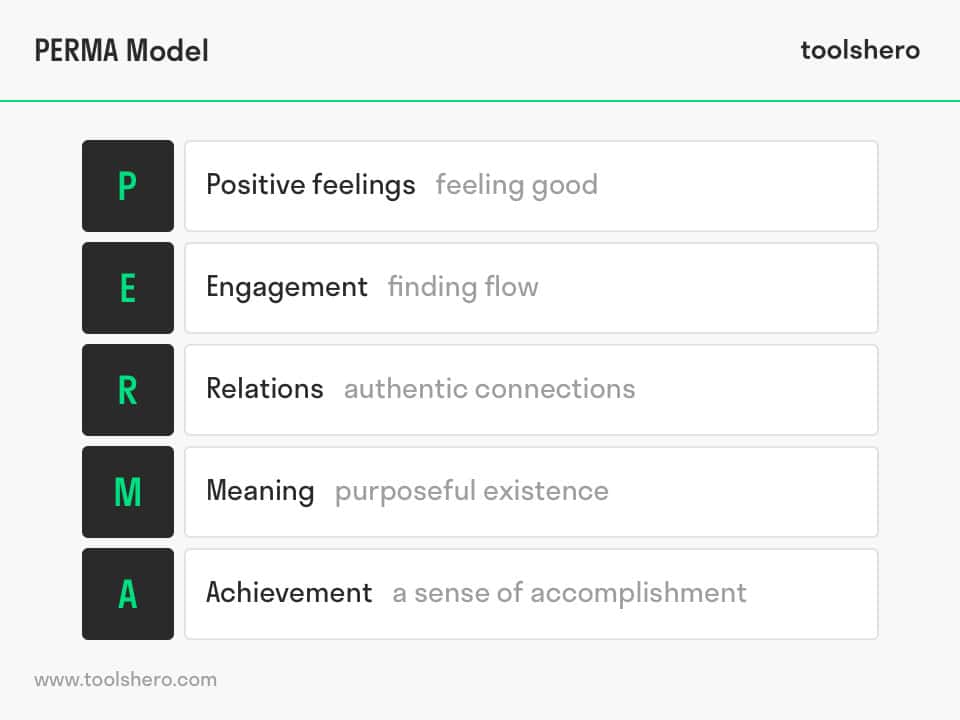PERMA Model of Wellbeing by Martin Seligman

PERMA Model of Wellbeing: this article explains the PERMA Model of Wellbeing, developed by Martin Seligman in a practical way. This article contains the definition of the PERMA Model, the meaning of each of the elements of the acronym, practical examples and a summary. After reading it, you will understand the basics of this stress management and Personal Happiness psychology theory. Enjoy reading!
What is the PERMA Model of Wellbeing?
The American psychologist Martin Seligman is considered to be the founder of positive psychology; a subject he studied extensively. He is associated with the University of Pennsylvania Positive Psychology Centre.
In 2011, his book Flourish was published, in which he describes the PERMA Model as a foundation for happiness and well-being. The PERMA Model of Wellbeing helps to understand the elements of happiness.
PERMA is the acronym for the five – according to Martin Seligman – important building blocks of well-being and happiness: Positive emotion, Engagement, Relations, Meaning and Achievement. Additionally, Martin Seligman indicates that each element of wellbeing and happiness has to have three characteristics itself, namely:
- Every element has to contribute to well-being and happiness;
- All elements are equally important;
- Every element has to be determined and measured independently from the other elements.

Figure 1 – 5 Elements of PERMA Model
Positive emotion, the first element of the PERMA Model of Wellbeing
As a human being, you should feel good and get hope and inspiration from the things you do. Positive emotions seem almost obvious when talking about happiness and well-being.
This emotion can already be felt when the first when life’s basic needs are satisfied. Examples would be food, drink and sleep. Only when those needs are satisfied, can people allow positive emotion through intellectual stimulation and creativity. Moreover, positive emotions help people to handle negative ideas. Positive emotions can only be assessed subjectively by the individual in question.
Online course: Positive Psychology Coaching
Engagement
This is about someone being completely engaged with his activities and carrying out his activities with passion and commitment. It is also described as the flow theory.
Just like positive emotion, engagement can only be measured subjectively. The more someone is involved with the work or task he is doing, the higher his level of engagement. On an additional note, he should also get energy from the activity and find it enjoyable.
After all, it requires a lot of stamina and concentration, but it will lead to a high level of engagement and productivity in the end.
Relations
How authentic is someone’s connection to the people around him? How is their interaction with colleagues, friends, family and other social connections? Happiness and well-being are inextricably connected to pleasant, useful and good interpersonal relationships.
The better these relationships are, the more they will lead to positive emotions and full support of each other. Social interaction with people and stable relationships lead to happiness and well-being. That is why it is good to start friendships and encourage others to do so as well.
This offers the foundation for good, trusting relationships that make people respect each other. This will improve the general quality of life.
Meaning
What is a person’s purpose in life and in what way does he contribute to the world around him and society in general? Which ideas and beliefs does a person have and what gives his life meaning?
To love and be loved inspires people to live and take care of themselves as well as others. When does a person live a meaningful life and what is that meaning? If someone has answers to all these questions and feels he has a higher purpose in life, than meaning has also been fulfilled as part of his happiness and well-being (Ikigai). Research has shown that religious and spiritual people particularly experience life as more meaningful than people who do not believe.
Achievement
This is about a sense of performance and success, about constantly challenging oneself and the opportunity to strengthen and improve one’s skills. Achievement is primarily about making efforts to improve one’s performance. That mainly involves challenges that help to improve a person’s self-image in order to allow him to be proud of the performance he delivered.
This strengthens confidence and that results in increased happiness and well-being. By setting feasible goals, people are actually able to achieve them. That will lead to a feeling of satisfaction and motivate someone to keep going.
Summary of the PERMA Model of Wellbeing
The PERMA Model of Wellbeing can help to increase people’s awareness. When a person is able to focus on the combination of all of PERMA’s elements (positive emotions, meaning, engagement, relationships and achievement), he will experience more happiness and well-being than people who have not managed all of these PERMA elements yet.
It’s Your Turn
What do you think? Have you ever heard of the PERMA Model of Wellbeing? Do you recognize the practical explanation or do you have more suggestions? What are your success factors for personal Happiness and well-being?
Share your experience and knowledge in the comments box below.
More information
- Khaw, D., & Kern, M. (2014). A cross-cultural comparison of the PERMA model of well-being. Undergraduate Journal opf Psychology at Berkeley, University of California, 8, 10-23.
- Seligman, M. E. (2012). Flourish: A visionary new understanding of happiness and well-being. Simon and Schuster.
- Slavin, S. J., Schindler, D., Chibnall, J. T., Fendell, G., & Shoss, M. (2012). PERMA: A model for institutional leadership and culture change. Academic Medicine, 87(11), 1481.
- Worfolk, C. (2024). Positive Psychology Coaching. Retrieved 02/15/2024 from Udemy.
How to cite this article:
Mulder, P. (2018). PERMA Model of Wellbeing (Seligman). Retrieved [insert date] from Toolshero: https://www.toolshero.com/psychology/perma-model/
Original publication date: 03/14/2018 | Last update: 02/15/2024
Add a link to this page on your website:
<a href=”https://www.toolshero.com/psychology/perma-model/”>Toolshero: PERMA Model of Wellbeing (Seligman)</a>












